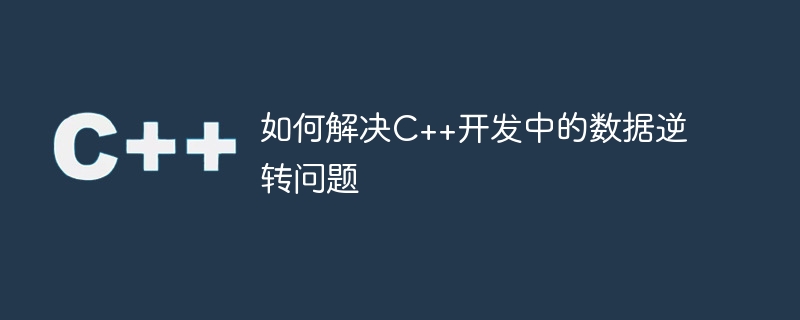Home >Backend Development >C++ >How to solve the data reversal problem in C++ development
How to solve the data reversal problem in C++ development
- 王林Original
- 2023-08-22 17:09:331746browse

How to solve the data reversal problem in C development
In C development, many times we will encounter the problem of data reversal, that is, reversing the order of a piece of data . This is very useful in many situations, such as string processing, array operations, etc. This article will explore how to solve the data reversal problem in C development and provide some practical methods and techniques.
1. Use standard library functions for reversal
C's standard library provides many convenient functions for reversal operations. The most commonly used function is std::reverse, which can be used to reverse the elements in a container. Before using this function, you need to include the header file <algorithm></algorithm>. The following is a simple example:
#include <iostream>
#include <algorithm>
#include <vector>
int main() {
std::vector<int> nums = {1, 2, 3, 4, 5};
std::reverse(nums.begin(), nums.end());
for (int num : nums) {
std::cout << num << " ";
}
return 0;
}Run the above code, the output result is: 5 4 3 2 1. By calling the std::reverse function, we successfully reversed the elements in the vector.
In addition to the std::reverse function, you can also use the std::reverse_copy function to reverse and copy data to another container. The following is a simple example:
#include <iostream>
#include <algorithm>
#include <vector>
int main() {
std::vector<int> nums = {1, 2, 3, 4, 5};
std::vector<int> reversed;
std::reverse_copy(nums.begin(), nums.end(), std::back_inserter(reversed));
for (int num : reversed) {
std::cout << num << " ";
}
return 0;
}Run the above code, the output result is: 5 4 3 2 1. As you can see, by calling the std::reverse_copy function, we successfully reversed and copied the elements in the vector to another vector.
2. Manual reversal
In addition to using standard library functions, we can also manually write code to achieve data reversal. The following is an example of manually reversing an array:
#include <iostream>
#include <vector>
void reverse(std::vector<int>& nums) {
int left = 0;
int right = nums.size() - 1;
while (left < right) {
std::swap(nums[left], nums[right]);
left++;
right--;
}
}
int main() {
std::vector<int> nums = {1, 2, 3, 4, 5};
reverse(nums);
for (int num : nums) {
std::cout << num << " ";
}
return 0;
}Run the above code, the output is: 5 4 3 2 1. By manually writing the reversal function reverse, we successfully reversed the elements in the array.
3. Notes
When performing data reversal, you need to pay attention to the following points:
- Ensure that the data structure supports the reversal operation, such as vectors, queues, stacks and other containers can Directly use the standard library function to perform the reversal operation;
- For containers that do not support the reversal operation, you can manually write the reversal function to implement it;
- Pay attention to handling edge cases, such as empty containers or containers with only one element Containers do not require reversal operations;
- When processing large amounts of data, the complexity of the algorithm must be considered and try to choose an appropriate algorithm to improve performance.
Summary:
This article introduces how to solve the data reversal problem in C development. By using standard library functions and manually writing reversal functions, we can easily perform data reversal operations. In actual development, choosing the appropriate method according to the specific situation and paying attention to handling boundary conditions and algorithm performance can improve the readability and execution efficiency of the code. Hope this article is helpful to everyone.
The above is the detailed content of How to solve the data reversal problem in C++ development. For more information, please follow other related articles on the PHP Chinese website!
Related articles
See more- C++ compilation error: A header file is referenced multiple times, how to solve it?
- C++ compilation error: wrong function parameters, how to fix it?
- C++ error: The constructor must be declared in the public area, how to deal with it?
- Process management and thread synchronization in C++
- How to deal with data splitting problems in C++ development

